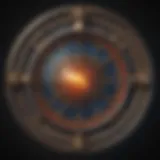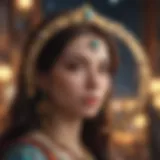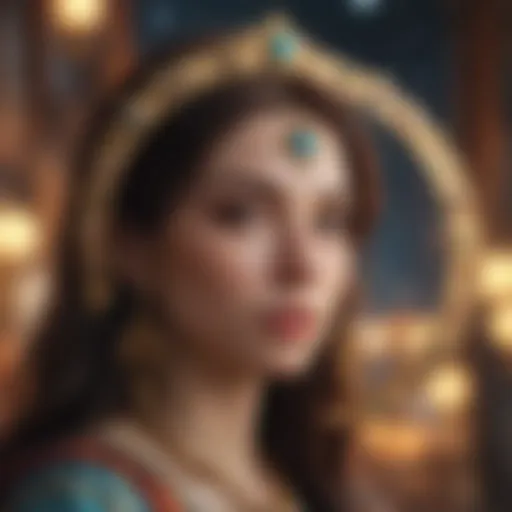The Evolution and Significance of Tarot Reading
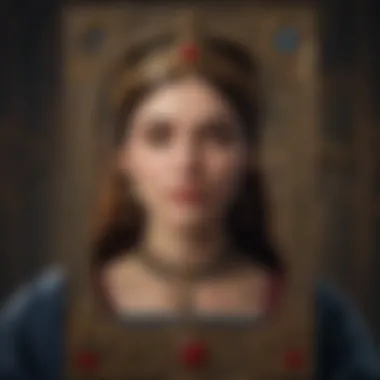

Intro
Tarot card reading is more than just a pastime for many. It is a window into an intricate tapestry of history, culture, and self-discovery. Born in the 15th century, tarot cards were initially crafted for play, known as tarocchi games in Italy. However, over the centuries, these colorful cards transformed into a vital tool for divination, spirituality, and personal insight. With roots entwined in mysticism and psychology, tarot serves to reflect not only the universe’s mysteries but also our innermost selves.
In this article, we embark on a journey through time, tracing the evolution of tarot from a game of chance to a respected art of reading and interpretation. We will uncover the figures whose contributions shaped its development, the decks that became iconic, and the socio-political influences that altered its course. Today, tarot resonates deeply in modern spirituality, being embraced by those seeking clarity amid life's chaos. By the end of this exploration, you will gain a nuanced understanding of tarot's enduring significance.
Origins of Tarot
The origins of tarot card reading are steeped in mystery and intrigue. Understanding this section provides insight into how tarot evolved from a mere parlor game to a profound tool for self-exploration and divination. This narrative helps illuminate the cultural significance of these cards, laying the groundwork for subsequent developments in their use.
Early Playing Cards
The journey of tarot begins in the 15th century in Europe, where the first known playing cards emerged. Initially, these cards were not designed for divination but were employed in games like tarocchi, a popular pastime among the Italian nobility. The early decks featured suits that resembled those of modern playing cards, such as cups, swords, coins, and batons, yet each card held unique imagery and artistry that conveyed more than just points in a game.
These early playing cards can be traced back to the Mamluk card decks that originated in the Middle East. As these decks traveled westward, they morphed into the versions recognized today. The formality of these decks was not merely for amusement; it represented social status and artistry, making them prized possessions for the elite. Cards like those from the Visconti-Sforza deck, with their meticulously painted images, hint at an intricate history of various cultural influences converging in the landscape of card playing.
"The card decks were a mirror reflecting the society of the time, blending luck, strategy, and artistry in a single sweep."
Development in Italy
As the tarot cards proliferated through Italy, they began to take on distinct forms, especially in regions like Milan and Bologna. The development in Italy was significant, as it shaped the evolution of tarot into what would eventually become a multifaceted tool for both play and divination. In this time, the tarot was still largely a game but began incorporating symbolic imagery and philosophical themes.
By the late 15th century, the cards became adorned with allegorical representations, marking a shift from mere gameplay to a medium of storytelling and introspection. This evolving art form reflected the complexities of the human experience, chaining realms of philosophy, spirituality, and psychology within each card. The transformations in the tarot's design during this period speak volumes about the cultural currents swirling in Renaissance Italy, influencing not only art but also the very notion of selfhood and destiny.
Through meticulous craftsmanship and evolving designs, Italy served as the cradle for what would blossom into the rich tradition of tarot reading that we recognize today. It laid the groundwork for future developments in tarot as these visual narratives began to draw parallels to astrological and mystical beliefs that would flourish in the ensuing centuries.
Transition to Divination
The transition from tarot as a mere card game to its role in divination is a pivotal chapter in the history of tarot reading. This evolution not only underscores the adaptability of the tarot as a cultural artifact but also reflects the changing perceptions of fate, spirituality, and the human psyche. Understanding this shift is crucial for astrologers, tarologists, and esotericists alike, as it highlights the intricacies involved in the practice of tarot reading today. The significance of tarot in divination lies in its unique blend of art, symbolism, and the human experience, allowing seekers to navigate the uncertainties of life with greater insight.
Tarot in the 18th Century
During the 18th century, tarot cards witnessed a remarkable metamorphosis. Previously limited to leisure, they began to attract the attention of philosophers and mystics who saw in them a path to deeper understanding. Figures like Antoine Court de Gébelin played a significant role in legitimatezing tarot as a tool for divination. His ideas suggested that tarot held ancient wisdom rooted in Egyptian lore, linking symbols and archetypes to spiritual truths.
In this era, the tarot emerged not just as cards but as a mirror reflecting collective human consciousness. Readers began to attribute meanings to the symbols on the cards, suggesting they could tap into the subconscious and discern insights about life's trajectory. The practice became associated with fortune-telling, attracting interest from various social strata.
Innovations in the designs of tarot decks—particularly with the introduction of the Tarot de Marseille—created clearer visual narratives. This evolution contributed to the emergence of standardized meanings for various card combinations, foreshadowing modern interpretations of the tarot.
Influence of Mystical Movements
The mystical movements of the 19th century significantly shaped the tarot's trajectory as a vehicle for spiritual exploration. In the backdrop of the Romantic era, there was a heightened interest in mysticism, the occult, and the esoteric. Tarot began to mingle with other systems of thought, most notably Kabbalah- a Hebrew mystical tradition. The integration of Kabbalistic ideas infused tarot with a new layer of depth and understanding, leading to a more spiritually inclined approach to card reading.
Eliphas Lévi, a prominent figure of the period, significantly contributed to this merging of ideas. He presented tarot as a gateway through which one could access the occult truths of the universe. Lévi's explorations emphasized the symbolism of the cards, presenting them as not just a deck but an essential component of a greater mystical framework.
This period also sparked a fascination with tarot within the context of psychology, paralleled by thinkers like Carl Jung, who acknowledged tarot as a tool for introspection and personal growth. The symbolic imagery of the tarot cards resonated deeply with Jungian archetypes, allowing individuals to confront their inner workings. Already, the practice was seen as a method for self-discovery, laying the groundwork for its modern application in therapeutic contexts.
"The tarot is a key; it opens doors into the very fabric of the subconscious, revealing hidden truths and archetypes that speak to our shared human experience."
As tarot evolved during this period, it began to blend with other mystical traditions and psychologies, paving the way for its current status in modern spiritual practices. This complex dance of cultural influences and interpretations explains why tarot is not just an amusement anymore but a profound means for many to understand their selves and the world around them.
Key Historical Figures
The narrative of tarot card reading is not just defined by the illustrations on the cards or the meanings attached to them. It is also greatly influenced by key historical figures who contributed exceptionally to its evolution. The insights, philosophies, and teachings of these individuals have shaped tarot's journey from leisure games to profound tools for divination and introspection. Understanding these figures provides a clearer picture of why tarot holds its position in modern spirituality and how its narrative continues to unfold.
Antoine Court de Gébelin


Antoine Court de Gébelin was a French clergyman and an early tarot scholar who played a pivotal role in conceptualizing tarot as a tool for divination. In his seminal work, Le Monde Primitif, published in 1781, he posited that tarot cards were an ancient Egyptian artifact, filled with esoteric wisdom. Although this theory is largely dismissed today, it sowed the seeds for the mystical associations that tarot enjoys now.
Gébelin's interpretations were driven by his belief in numerology and the link between tarot and Kabbalah. He saw the tarot deck as a means to uncover hidden truths about the self and the universe. By claiming that the Tarot was a remnant of ancient wisdom, he set the stage for its practice in personal development and spiritual exploration.
His work ignited interest in tarot beyond mere cards, prompting esoteric circles to delve deeper into its meanings and applications, paving the way for future interpretations by scholars and practitioners alike.
Eliphas évi
The next significant figure in the tapestry of tarot's history is Eliphas Lévi, born as Alphonse-Louis Constant in the early 19th century. Lévi's contributions were profound, particularly his effort to catalog and formalize the theories surrounding magic and, by extension, tarot. He is most recognized for his book, Dogme et Rituel de la Haute Magie, where he proposed that tarot was not just a set of divinatory cards but a comprehensive system of occult knowledge.
Lévi emphasized the importance of the Major Arcana, viewing these cards as archetypes of significant human experiences and spiritual lessons. His work laid the groundwork for connecting tarot with a wider array of mystical practices, including astrology and alchemy. Lévi's vision shaped a new understanding of how tarot can be utilized in the search for self-knowledge, significantly impacting how both practitioners and seekers approach tarot today.
Pamela Colman Smith and the Rider-Waite Deck
No discourse on tarot could overlook Pamela Colman Smith, an artist and mystic responsible for creating one of the most influential tarot decks known to date, the Rider-Waite deck, illustrated in 1909. Collaborating with Arthur Edward Waite, Smith infused her vision into this deck, which presented rich imagery that made tarot accessible and relatable to a broader audience.
Her contribution is particularly notable for introducing illustrated scenes to the Minor Arcana, which enhanced intuitive interpretation. Rather than simply depicting the four suits, her designs included narrative elements that made tarot readings more vivid and dramatic.
The Rider-Waite deck became the cornerstone for many modern tarot readers, ensuring that Smith's artistic legacy not only transformed how tarot was practiced but also how it looked. Her unique take on imagery guided future generations of tarot practitioners and artists, establishing an enduring symbol of tarot's mystical presence in contemporary culture.
"In the tarot, each card acts as a mirror, reflecting the inner world of the reader who seeks knowledge and understanding."
Through these key historical figures—Antoine Court de Gébelin, Eliphas Lévi, and Pamela Colman Smith—the depth of tarot's narrative expands, revealing layers of meaning that transcend the games it once served. They collectively nurtured the rich symbolism and complexity of tarot, shaping it into the insightful and multifaceted practice we recognize today.
Major Tarot Decks Through History
The exploration of tarot card reading is incomplete without a thorough understanding of the major tarot decks that have shaped its evolution. Each deck serves as a mirror to the cultural, historical, and artistic milieu of its time, offering a snapshot of societal values and beliefs. From the intricate designs of the Visconti-Sforza deck to the vibrant symbolism of the Marseille Tarot, each has left an indelible mark on how tarot is interpreted and used in divination today. The significance of studying these decks lies not just in their aesthetic value, but also in how they have influenced tarot practices and interpretations across the globe.
Visconti-Sforza Deck
The Visconti-Sforza deck, believed to be one of the earliest surviving tarot decks, was commissioned by the Duke of Milan and reflects the artistic finesse of 15th-century Italy. This deck showcases finely painted cards, adorned with intricate illustrations that depict noble figures, natural elements, and allegorical motifs. One key aspect of the Visconti-Sforza deck is its rich symbolism that is deeply entwined with the political and social landscapes of the time.
The Visconti-Sforza deck not only offers a visual feast but also serves as a historical artifact, tracing the confluence of art, psychology, and power.
Some of the notable elements include:
- Artistry and Detail: Each card exhibits meticulous craftsmanship, showcasing the artistry of the Renaissance period.
- Cultural Reflection: The imagery often reflects the virtues and vices prevalent in that society, allowing for a nuanced understanding of human behavior.
- Early Archetypes: Many archetypes first seen here are essential in modern tarot, such as The Fool and The Lovers, connecting historical readings to contemporary practices.
Marseille Tarot
The Marseille Tarot emerged as a seminal deck in the 17th century and played a crucial role in the development of tarot as a divination tool. Characterized by its bold colors and simplified iconography, this deck has become one of the most popular and influential tarot decks worldwide. The Marseille Tarot holds a unique position, as it emphasizes the readability of the cards, making it accessible to both novices and experienced readers.
Some defining characteristics of the Marseille Tarot include:
- Simplicity in Design: Unlike the ornate designs of earlier decks, the Marseille Tarot employs clear, straightforward images that focus on essential symbolism.
- Trumps and Pips: The deck includes both trump cards (Major Arcana) and pip cards (Minor Arcana), allowing for diverse combinations and readings.
- Historical Use: For many centuries, this deck has been utilized by fortune-tellers and common folk, embedding it deeply into the tarot fabric of society.
Thoth Tarot
The Thoth Tarot, developed by occultist Aleister Crowley in the early 20th century, is another pivotal deck that has left a strong legacy in both tarot reading and esoteric practices. The Thoth Tarot stands apart with its profound mystical insights and vibrant imagery, inspired by various philosophies including Kabbalah, astrology, and alchemical traditions. Crowley’s attempt was not just to create another tarot deck but to expand the horizons of astrological and mystical understanding.
Key aspects of the Thoth Tarot include:
- Complex Symbolism: Each card is rich with multi-layered meanings, inviting extensive interpretation and deep reading.
- Astrological Associations: Crowley integrated astrological symbols, making the deck a practical tool for astrological readings.
- Artistic Innovation: Designed by Lady Frieda Harris, the Thoth Tarot incorporates a blend of abstract designs and vivid colors that challenges traditional representations, pushing the boundaries of artistic expression within tarot.
In summary, each deck discussed here has contributed to the vast tapestry of tarot’s history, influencing not just how cards are read, but also the symbolic interpretations that continue to evolve. A deeper understanding of these decks allows modern tarot readers to appreciate the historical context, richness, and complexity behind the cards they use in their practice.
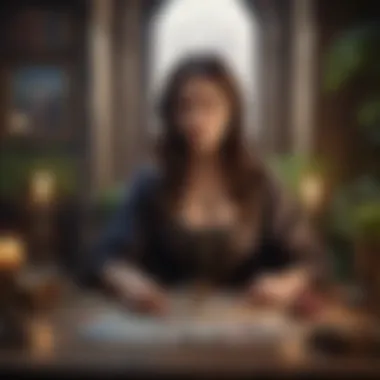

The Symbolism of Tarot Cards
The world of tarot is rich with symbolism, serving as a multifaceted mirror reflecting human experience. Each card embodies meanings that extend far beyond mere visuals. Understanding this symbolism is crucial for both practitioners and enthusiasts of tarot. By diving into these symbolic layers, we unveil a deeper comprehension of the cards' messages, providing insights into our inner landscapes, as well as the external challenges we face.
The symbolism in tarot operates on two primary levels: archetypal and personal. The cards resonate with universal themes, while also catering to individual interpretations, making the tarot a unique tool for introspection. Whether you are seeking guidance, clarity, or a deeper connection with the self, the symbols embedded within tarot cards can guide the way.
Major Arcana: Archetypes and Themes
The Major Arcana consists of 22 cards that are considered the heart of the tarot deck. These cards exemplify fundamental life experiences and archetypes that resonate across cultures and eras. For instance, cards like The Fool, The Lovers, and The Tower speak to the spectrum of human emotions, relationships, and crises.
- The Fool represents new beginnings, spontaneity, and a leap of faith. It encourages one to embrace the unknown, often reflecting the start of a journey.
- The Lovers is not just about romantic relationships. It also captures themes of duality, harmony, and choices.
- The Tower warns of upheaval, challenging individuals to confront chaos as a precursor to transformation.
Each of these cards encapsulates transformative concepts that invite introspection. The Major Arcana speaks a universal language, resonating with archetypes deeply ingrained in the collective consciousness.
Minor Arcana: Everyday Life and Challenges
The Minor Arcana, comprising four suits—Wands, Cups, Swords, and Pentacles—delves into the daily struggles and accomplishments of life. Where Major Arcana deals with significant shifts and major life events, Minor Arcana illustrates the details of the day-to-day journey.
- Wands often symbolize inspiration, action, and ambition, relating to creativity and personal projects.
- Cups connect with emotions and relationships. They represent our feelings, intuitions, and connections with others.
- Swords denote challenges, conflict, and intellectual pursuits. They urge reflection on our thoughts and decision-making processes.
- Pentacles reflect material aspects of life such as work, finances, and tangible achievements.
In combination, these cards weave a tapestry of life's complexities, demonstrating how small everyday occurrences can shape our life narrative. They remind practitioners to remain grounded, ensuring that, while exploring transcendent themes, we do not overlook the significance of quotidian experiences.
The beauty of tarot lies in its ability to guide us through the serene and stormy seas of existence, revealing insights that are often hidden beneath the surface.
Cultural Impact of Tarot
The impact of tarot extends far beyond the cards themselves, weaving a rich tapestry within literature, art, psychology, and contemporary society. Understanding its cultural significance allows one to appreciate how tarot has transitioned from a mere divinatory tool into a multifaceted cultural phenomenon, influencing countless creative and psychological landscapes.
Tarot in Literature and Art
The imagery of tarot has vividly captured the imaginations of many writers and artists throughout the ages. From Crowley’s poetic descriptions in The Book of Thoth to the evocative artwork of Pamela Colman Smith in the Rider-Waite deck, tarot has provided a wellspring of inspiration. Authors, especially in the realm of fantasy and magic realism, often draw upon tarot symbolism to create compelling narratives. For instance, authors like Neil Gaiman and Susan Sontag have referenced tarot themes to explore deeper truths about human experience.
In visual arts, tarot has seen increased integration into various artistic expressions. Artists, modern and classic, have used tarot's narrative potential to question reality and explore the subconscious. Consider how Salvador Dali's interpretations of tarot cards communicate surrealism through the lens of the archetypal. The blending of tarot with artistic expression highlights themes of fate, choice, and the human experience in ways that speak to both the heart and intellect.
"The tarot is a mirror, reflecting the inner landscapes of the soul back to us."
— Anonymous, tarot enthusiast
Tarot and Psychology
Tarot's relationship with psychology forms another layer of its cultural impact. Historically, figures like Carl Jung recognized the therapeutic potential of tarot as a framework for introspection. Jung’s exploration of archetypes resonates profoundly with the symbolism found in tarot. The Major Arcana, with its rich archetypal imagery, offers individuals a pathway for self-reflection, allowing them to pinpoint their current life phases and emotional states.
Modern practitioners have embraced this therapeutic application of tarot, often weaving it into coaching and counseling practices. By engaging with tarot, individuals can unlock subconscious thoughts and feelings, paving the way for deeper self-discovery. The cards serve as prompts, inviting seekers to explore their fears, dreams, and desires in a structured yet somewhat uncharted manner.
- Key aspects of tarot in psychology:
- Self-reflection: The process encourages individuals to examine their inner lives.
- Symbolism and Archetypes: Each card can resonate uniquely with different people, creating a personal reading experience.
- Therapeutic Engagement: Many find that discussing cards can help externalize internal struggles.
This complex interplay between tarot and psychology has not only broadened the appeal of tarot reading but has also contributed to its acceptance in a wider context, transcending stigmas surrounding divination as mere superstition.
Modern Applications of Tarot
In recent years, there has been a remarkable resurgence in the interest surrounding tarot card reading, not merely as a form of divination but as a multifaceted tool that intersects with modern practices of therapy, self-reflection, and online engagement. This section delves into the important aspects of tarot's contemporary applications, emphasizing how it serves both as a psychological aid and a cultural phenomenon in the digital age. Understanding these applications enriches the reader's appreciation of tarot, fostering a broader perspective on its relevance today.
Therapeutic Uses of Tarot
The therapeutic potential of tarot is gaining traction among mental health professionals, who see it as a unique vehicle for fostering introspection and self-awareness. Unlike traditional psychotherapeutic methods, tarot card reading facilitates discussion in a way that can feel more accessible and engaging for some individuals. For many, the archetypical imagery and narratives of the cards serve as a mirror, reflecting their internal struggles and aspirations. By interpreting these symbols, clients can gain novel insights into their emotional landscape.
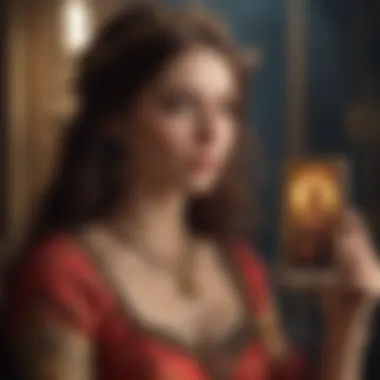

Benefits of Therapeutic Tarot:
- Accessible Language: The visuals of tarot often provide a common language for discussing feelings and experiences, making it easier for clients to express themselves.
- Creative Exploration: Tarot invites a creative approach to problem-solving, encouraging individuals to explore potential outcomes and perspectives that they may not have considered otherwise.
- Integration of Mind and Spirit: This practice blends cognitive and intuitive processes, appealing to those who seek a holistic approach to healing.
Cathy, a therapist who uses tarot in her practice, notes, "When my clients draw the Eight of Cups, it often leads them to talk about what they wish to leave behind. It’s a powerful catalyst for transformation." Such experiences illustrate how tarot can play a supportive role in personal growth and emotional healing.
Online Tarot Reading Trends
The rapid growth of the digital world has birthed new avenues for tarot reading, making it accessible to a broader audience. Online tarot readings have exploded in popularity, with websites and social media platforms offering services from seasoned professionals to startups. This shift to virtual platforms has not only made tarot more accessible but has also transformed the community aspect of tarot reading.
Elements of Online Tarot Reading:
- Versatility: Clients can receive readings via video calls, chat, and even recorded sessions, allowing them to choose what feels most comfortable.
- Increased Awareness: Social media has paved the way for tarot enthusiasts to share interpretations and insights, creating a rich tapestry of collective knowledge.
- Global Reach: A reader in New York can now connect with clients from Sydney, broadening the perspectives and cultural nuances shared in readings.
With platforms like Facebook and Reddit surfacing as hubs for discussion and collaboration, individuals seeking guidance can easily engage with a diverse array of voices in the tarot space. This cultural melting pot enhances the overall tarot narrative, enabling each user to gain uniquely tailored insights. Many in the community confidently declare, "Tarot has transcended geographical barriers, fostering a global dialogue on self-exploration and spirituality."
This melding of ancient practices with modern sensibilities showcases tarot not just as a relic of the past but as a vibrant, relevant part of contemporary life.
Criticism and Skepticism
The realm of tarot card reading is often twined with a thick thread of skepticism. It’s crucial to unravel this skepticism, not only to appreciate the art of tarot itself but also to understand the broader societal dynamics surrounding divination practices. Critics frequently challenge the validity and efficacy of tarot readings. They question whether these cards, steeped in symbolism, can genuinely provide insights into one’s life or future. By exploring criticism and skepticism, we uncover layers about human beliefs, fears, and desires—elements that are intrinsic to our understanding of tarot.
Historical Prejudice Against Divination
Looking back, the roots of criticism against tarot and other forms of divination stretch deep into history. Many cultures viewed mysticism with a suspicious eye. Particularly during periods of religious fervor, tarot card reading often garnered harsh condemnation. The fear of the unknown and the association of divination with witchcraft contributed to the vilification of tarot. Individuals practicing this form of divination could find themselves at odds with established religious authorities or traditional societal expectations.
Research shows that during the Middle Ages and the early modern period, tarot was often condemned as a mechanism of manipulation or a path to heresy. Those who turned to tarot for guidance were sometimes viewed as straying from prescribed religious teachings. In essence, this prejudice pointed to a wider societal fear of losing control—control over beliefs, destiny, and communal norms.
"The history of tarot reflects not just the evolution of a practice, but also the evolution of thought in relation to destiny and free will."
Contemporary Debates on Efficacy
In contemporary discussions, the scrutiny of tarot takes on new dimensions, reflecting current cultural beliefs. A number of advocates argue that tarot is more than mere superstition. They suggest it acts as a tool for self-reflection, perhaps even a psychological mechanism, helping individuals navigate complex emotions and situations. On the other hand, skeptics continue to question the psychological underpinnings of such practices. Is it merely suggestion at play, or can these cards genuinely influence life's direction?
Many modern skeptics cite a lack of empirical evidence supporting the efficacy of tarot readings. They argue that like any form of divination, it runs the risk of the placebo effect—people believing in their fortune simply because they want to, rather than because tarot has any power of foresight.
This debate touches on deeper questions: How much control do we have over our destinies? When faced with ambiguity, do we seek answers in the stars, cards, or within ourselves? Ultimately, the current skepticism regarding tarot serves as a mirror reflecting the broader inquiries of meaning, belief, and personal empowerment in an oft-chaotic world.
The Future of Tarot Card Reading
The trajectory of tarot card reading is shifting in interesting ways, reflecting both cultural changes and advancements in technology. As society moves towards a more individualized and introspective approach to spirituality and self-discovery, tarot continues to evolve, merging its ancient roots with contemporary practices. Understanding this future is vital, not just for practitioners, but also for those interested in the broader implications of tarot's ongoing transformation and its place in modern life.
Evolving Interpretations
With every generation, interpretations of tarot cards have shifted, influenced by collective experiences, societal values, and personal insights. The cards, once seen merely as mystical tools, are increasingly viewed through diverse lenses, from psychological frameworks to socio-spiritual contexts.
One of the key elements in this evolution is the personal connection individuals forge with tarot. Traditionally, tarot readings might have been confined to a set of pre-defined meanings. Now, however, many readers emphasize intuitive interpretation, suggesting that each reading can differ dramatically based on the reader’s personal insights and the querent's emotional state.
This shift encourages a more democratic view of divination. Practitioners no longer rely solely on rigid traditional interpretations but adapt meanings to suit modern contexts. For instance, cards like The Tower, typically associated with chaos and upheaval, are increasingly interpreted as opportunities for awakening or personal growth. Such evolving interpretations make tarot more accessible, inviting more people to delve into this ancient practice.
Integration with Digital Culture
In our fast-paced digital age, tarot is not confined to dusty books or shadowy parlors. Social media platforms and online communities play a pivotal role in how tarot is practiced and understood today. Tarot readers and enthusiasts share insights, techniques, and readings across platforms like Instagram, YouTube, and TikTok, promoting a culture of sharing that was unthinkable in previous generations.
"The blend of tarot with digital culture means that information spreads like wildfire, and new interpretations are constantly emerging."
Digital tools also allow practitioners to offer remote readings, breaking geographical barriers. Many now utilize platforms like Zoom or Skype for personalized sessions, catering to clients from all corners of the globe. Furthermore, innovative apps are springing up, making tarot card reading accessible from the palms of people's hands, providing interpretations, card meanings, and daily draws.
This integration not only democratizes tarot but also introduces new audiences to its practices. As more people engage with tarot online, there's a risk of misinterpretation and oversimplification. However, the potential for deeper discussions and shared learning ultimately enriches the tarot community, leading to a future where tarot can speak to the complexities of modern life.
In summary, the future of tarot card reading is rich with possibilities. As interpretations evolve and digital culture expands, this ancient practice remains relevant, fostering connection and insight in a rapidly changing world.
